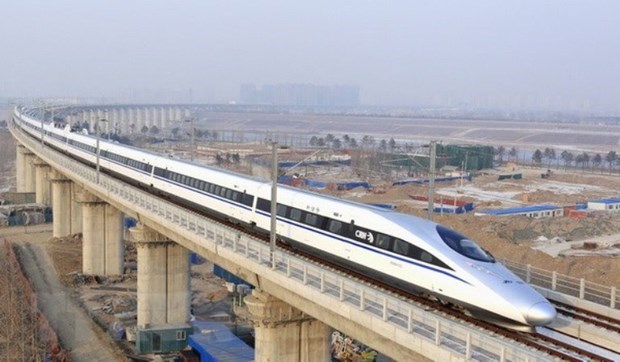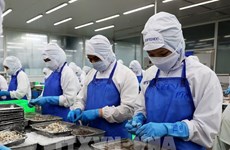At least 20 years needed for North-South express railway: insider
A leader of the Vietnam Railway (VNR) Corporation said no countries in the world can complete a national express railway system within a few years because that work needs at least about 20 years.
 The construction of the North – South high-speed railway will cost about 58.7 billion USD (Photo: Xinhua/VNA)
The construction of the North – South high-speed railway will cost about 58.7 billion USD (Photo: Xinhua/VNA)Hanoi (VNA) – A leader of the Vietnam Railway Corporation (VNR) said no countries in the world can complete a national express railway system within a few years because that work needs at least about 20 years.
If the North – South high-speed railway is built, it will cut down the time needed to travel from Hanoi to Ho Chi Minh City to nearly seven hours, thus easing pressure on road transport, reducing traffic accidents, improving national competitiveness and facilitating transport activities.
Seven hours to travel from Hanoi to HCM City
The project will have the total length of 1,559km, running alongside the North – South corridor through 20 localities, from Hanoi to HCM City. It will include 14km sharing the same infrastructure with the urban railway route No. 1 of Hanoi (the section from the Hanoi station to the Ngoc Hoi station). The remaining 1,545km will run from the Ngoc Hoi station in the capital city to the Thu Thiem station in HCM City.
The railway, to be built for passenger transport, will have the design speed of 350km per hour and the operational speed of 320km per hour. Its investment totals more than 1.33 quadrillion VND (58.7 billion USD).
Construction is set to be divided into two phases, with the first to be invested with 561.6 trillion VND (24.7 billion USD) and the second 772.6 trillion VND (34 billion USD).
From 2020 to 2032, the stretch from Hanoi to Vinh city and the one from Nha Trang city to Ho Chi Minh City will be built. Meanwhile, the construction of the Vinh – Nha Trang section will last from 2032 to 2050, with the Vinh – Da Nang section to be completed in 2040 and the Da Nang – Nha Trang section in 2050.
[Pre-feasibility study of high-speed railway project submitted to PM]
The journey time from Hanoi to HCM City will be 5 hours and 20 minutes (excluding stops at stations) and 6 hours and 55 minutes (including stops at all stations). Trains will run every 6 – 24 hours.
Meanwhile, the management and operation of the railway will be separated. A State-owned corporation will be established to manage the infrastructure, and the investor will set up companies to operate the railway.
With regard to project funding, the Ministry of Transport’s study report proposed the State invest 80 percent of the project’s total capital, and private capital account for some 20 percent. According to the consulting firm, this ratio is feasible in terms of financial efficiency.
The study report analysed that in case the project is funded completely by domestic sources, the annual investment value will account for 0.7 percent of the gross domestic product (GDP) at the maximum in the first phase, and 0.55 percent of the GDP in the second phase. In case all capital of the project is borrowed, with the current use and repayment of public debt by the Government, the project will not make the public debt ceiling of 65 percent of the GDP be breached.
Private funding for whole project unfeasible
VNR Chairman Vu Anh Minh said high-speed railway is necessary for the economy, and it should have been developed first. However, it’s better late than never so as to balance different means of transport.
He noted that no countries in the world can complete a national express railway system within a few years because at least about 20 years are needed for that work.
[Vietnam recommended to develop high-speed railway]
If the project is approved by the National Assembly by the end of this year, it will need at least three years to complete the prefeasibility study report, and construction can begin in 2022 at the soonest. In that case, several sections of the project can be put into operation after about 5 – 7 years, Minh said.
Regarding private funding for the railway sector, he said even in developed countries, they are still unable to make privatisation, but the State has to directly invest in railway infrastructure because investment costs are too big and the capital recovery period is long. Therefore, only the development of stations and dry ports can attract private funding.
Additionally, he added, building railway is not for railway businesses but to serve socio-economic development, reduce logistics costs, promote national competitiveness and facilitate transport. This should be the target of investment, and railway firms are set up only to manage and optimise the State’s infrastructure investment./.












